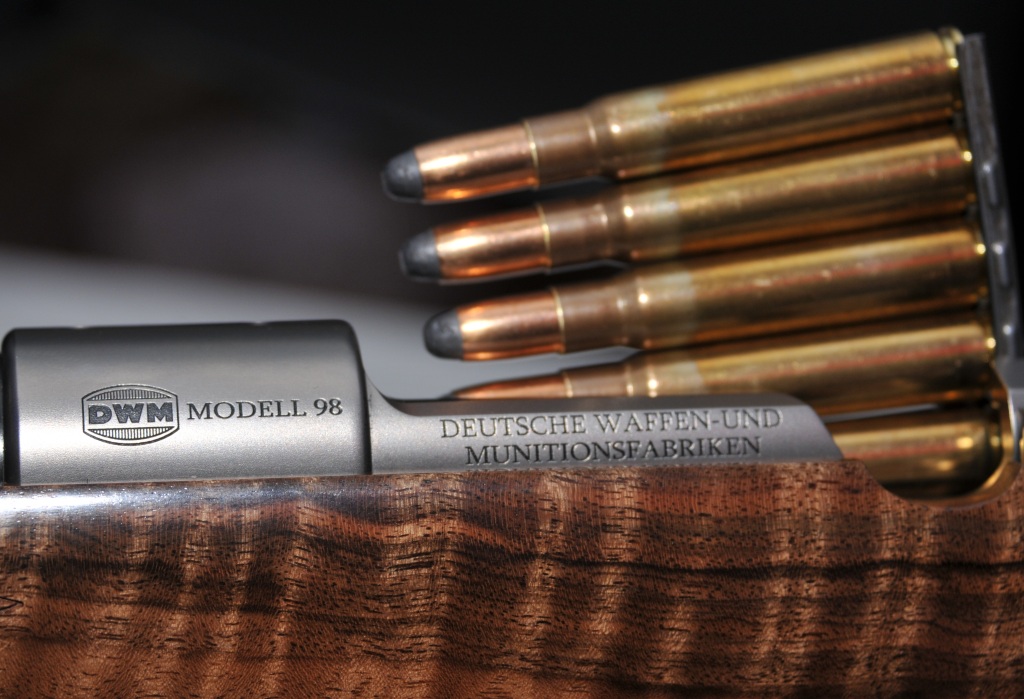
Before reading… In Italian the 8 number is pronounced “Otto”, that is also a german name. So i gave this nickname to my old K98, Otto, being chambered in 8x57JS, in the article i’ll frequently refer to this caliber with this nickname.
Strange fate, for the old venerable “Otto”. Born from the Gewehr-Prüfungskommission , served Germany in two world wars, overcoming brilliantly the century of life without the inexorable time flow affected its extraordinary effectiveness.
This elderly old-timer took up service in the far 1888. World was profoundly different from today’s, But then as now, Nations’ power and prestige were measured on bayonets tips. Only a few decades had passed from the Risorgimento wars; This German caliber, together with the weapon that brought it to battlefields, was destined to revolutionize military doctrine, tactics and the very use of the infantry. A few years earlier, Garibaldi had stated that “Rifle was only bayonet’s handle extension”, declaring to the world how inefficient and reliable weapons were at that time. Suddenly world changed, in 1888.
The 8x57J military cartridge was created to work with Gewehr 88, an engineering triumph. The first rifle action of the modern era, reliable and damn efficient, could only chamber the most performing cartridge that human mind had ever created. Topped with a 227-grain Round Nose full jacketed bullet, (.318 inch), the M88 cartridge hid a technological heart: 2.75 grams of monobasic Nitrocellulose powder, able to push the heavy bullet to 620 ms, with devastating energy and flat trajectory. The new powder guaranteed exceptional performance: the shot didn’t produce smoke column ahead infantry, revealing position and making it blind at the same time. Bullet’s speed was significantly higher than black powders ammunitions, and finally Temperature and humidity didn’t affect ballistics. The newborn 8x57j was the champion of his era, redesigning military strategy and giving undisputed advantage to Prussian infantry. Needless to say, it litterally threw half Europe’s military staffs into panic. Infantry well trained with similar weapon-ammunition combination would have overwhelming advantage, with greater range engagement capabilities, higher lethality and a reliability that had no competitors. Run-up was long: today we can say that technological and ballistic gap were never bridged, at least until 1945. British Army developed the remarkable .303 British, Russians the 7.62x54R, and Americans the admirable 30.06. None of these, however, can beat the good 8 × 57. The British caliber is accurate, but it has suffered propellents problems until the end of its service, especially in hot temperatures. 30.06 enjoyed and enjoys an indecent diffusion, but he never lost Flyers bad habit, and after all the obsolete design decreed the end of his military career: too long for high rate of fire weapons, too powerful for a light ful automatic weapon. The Soviet 7.62x54R was perhaps the only one to withstand the impact, thanks to exorbitant industrial production: crude perhaps but reliable and accurate. During the Second World War it was said that British went to war with a target rifle, Germans with a hunting one, and only Americans had a battle rifle.
It is useless to look for this tale’s origin. Meanwhile, Mauser brothers had not sat on laurels, they were relentlessly developing and improving weapon systems. The cartridge was modified with a new ogive, .323 diameter, 154 grains weight,capable of 870 ms muzzle velocity . Powder was for the first time a dibasic, Nitrocellulose and Nitroglycerin, an innovative solution that placed this new cartridge on a considerably higher level.
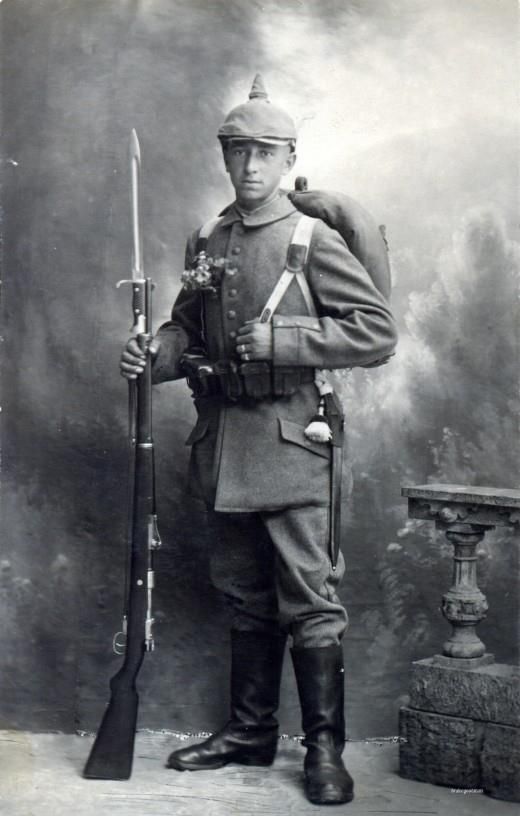
To avoid dangerous errors, the new ammunition assumed the Official nomenclature of 8 × 57 JS, where the suffix stands for Infanterie Spitz Geschoss, spitzer bullet for infantry. Definitively entered in service in 1905, causing a further upheaval in European military staffs, whose generals had probably been trained with Napoleonic doctrines, completely unable to fully understand the extent of the change.
In 1933, when Germany had started armament race again, the old K98 underwent a substantial overhaul, and with it the ammunition . The bullet chosen, needless to say, was a ballistics champion. A 13-gram spitzer bullet with boat tail design, capable of speed and flatness unattainable by other European military calibers: 760 ms at the muzzle, supersonic up to 1000 meters, thanks to an exceptional ballistic coefficient, just over .590. The new heavier bullet was essential to allow perfect combustion in shorter k98’s barrel, and was designed to be accurate, and penetrate light armor thanks to its steel mantle. The old 154-grainers were retired. During the second wordl war, any kind of ammunition were produced, from the tracer ones (day and night) to the incendiary ones for aeronautical use, up to lighter bullets with special armor for precision weapons for long range sniping.
All were used, without any problem in the armed forces rifle, the K98. Never in human history a weapon and a cartridge have closely tied their fates as the K98 and 8x57JS.
If on the one hand this allowed its first worldwide diffusion, it subsequently led to a premature decline.
The venerable K98 was the German armed forces backbone in two world wars. No other rifle has infected the collective imagination as much as this one. If we ideally think to a Bolt action we will immediately have in mind the 98’s silhouette.
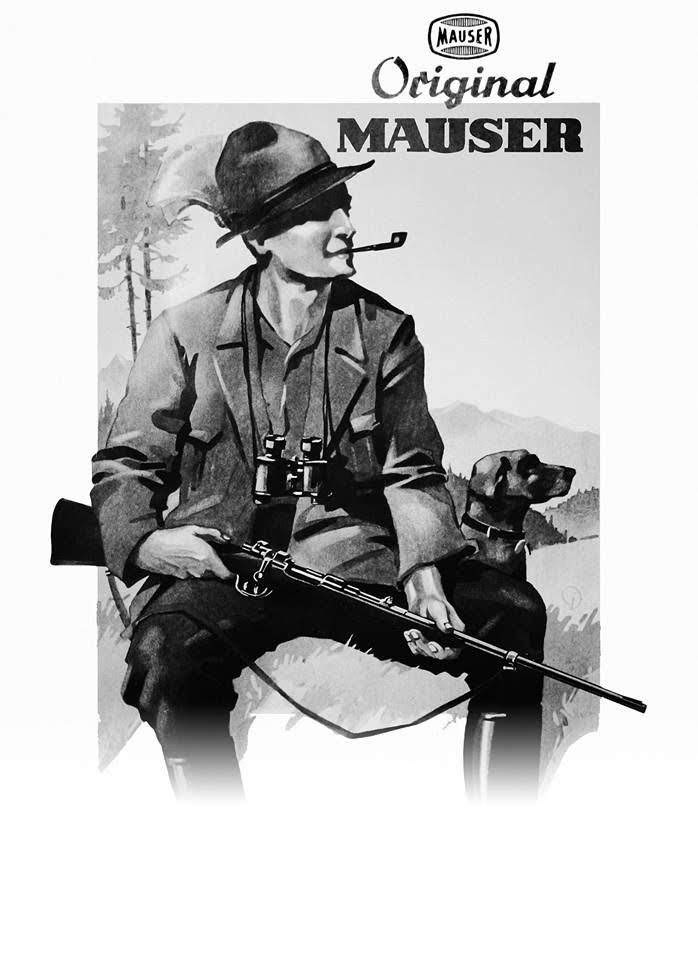
This ballistic system’s heart, which reached us unchanged after almost 150 years, is the magnificent Mauser action.
Traditional configuration reckon on 90 degrees bolt rotation to open the action. Together with the wise case design and the good weapon’s workmanship, this aspect guaranteed a smooth extraction, free from any kind of sticking and jamming. Even with extremely dirty chamber and desperate conditions, the 98 action guaranteed, and still guarantees, spectacular reliability. The project solidity, with 3 tenons, is a policy against overpressure accidents, always possible on the battlefield: it was practically impossible to keep the barrel free from mud in a trench war . The K98 safety was and still remains a shining example of design genius. First of all, characteristic flag shape has several purposes. It can be easily operated with gloves or, worse, with mud, blood and sweat dirty hands. Transition from the intermediate position, in which it is possible to open the bolt with gun on safety, to fire position is immediate, right thumb operated in a second. With the safety on the xtreme right, the bolt lever is locked, and the gun is obviously on safety. This aspect makes it easy to understand battle weapon reliability. A locked bolt is safe inside a trench, during a parachute jump or ski descent. Anyway, the aspect that most distinguishes K98 safety system is another. Unlike all the systems conceived until then, Mauser safetyis really “safe”. Acting on the flag, firing pin is blocked by a recess in the breech profile. Practically, it cannot advance, unless it smashes a 2 cm block of German steel . This allows to carry the gun in total safety with ammunition chambered and actually loaded. If you think this is a little advantage you are wrong. During the Second World War, many weapons, especially automatic ones, caused fatal accidents. All submachine guns were designed to fire with bolt opened, and if this greatly increased the firing volume it made them prone to accidental shots . In some cases, like STG44 for example, primer’s construction combined with weapon’s mechanics was infamous for generating disasters.
Follow us on:
https://www.facebook.com/groups/1100509527013603/?ref=share
All these casualties were impossible with K98, a safe and robust weapon above all others. War demands soon revealed how much tactics had changed. Progressive infantry mechanization , the increasing airforce power and conflict’s displacement from open field to inhabited centers had lead to new doctrines, determining powerful cartridges like 8x57JS obsolete. Since gun fights mostly took place at close range, an accurate and deadly 1000 meters’ cartridge was useless. Submachine guns, able to spit a lead stream in seconds, soon replaced the long and uncomfortable carbines. Old doctrine had left space to new concepts such as area saturation, fire volume , all summarized in the American motto “Spray and Pray”. Soldiers preferred to carry hundreds of small and light bullets rather than thirty long and heavy cartridges in an urban theater. Final evolution was the Sturmgewer 44 birth, the first assault rifle in history, conceived to give high fire power within 500 meters. Devastating power demonstrated by this revolutionary weapon with arrest troops was disruptive.
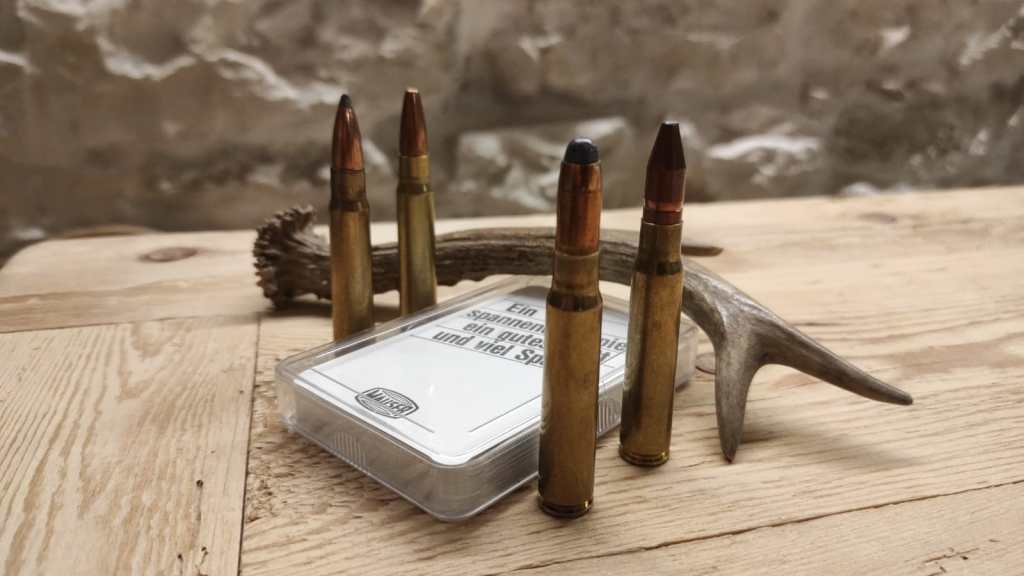
Together with Panzer Faust it certainly was the main weapon used in the strenuous defense, in the spring of ’44.
The end of the second conflict saw Germany and its companies destroyed again. Heavily bombed Mauser factories were razed to the ground like most ammunition companies. It could have been the K98 system end, but times were difficult and due to war economy harshness, confiscated German Mausers were not destroyed. Many European armies, dismantled by German invasion years earlier, had to be rearmed, and German warehouses were full of perfectly tidy weapons. Project goodness extended its operational life for a few decades. Even today, in half world conflicts, if you look accurately you could see an old K98 in combat, still capable of remarkable performance. Thousands of remnants made their way to the United States, and many more landed in Australia. In a few years civilian market was invaded by these efficient weapons, now devoted to hunting. With a few dollars it was possible to sporterize a K98, stripping off its uniform and making it an effective hunting tool.
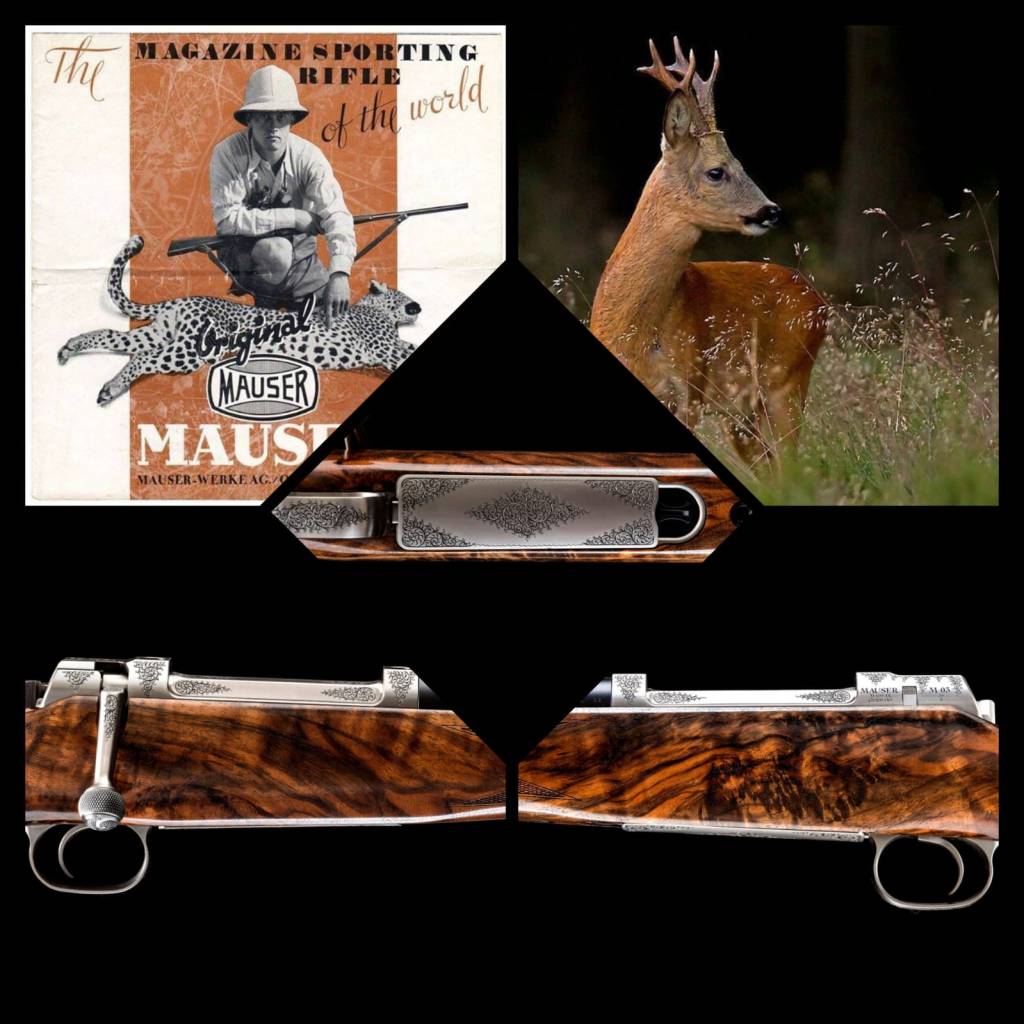
So Americans and Australians began to appreciate ballistic qualities of our 8x57JS. Many of those who had suffered the heavy 8mm bullets effects, ended up appreciating their hunting skills. History sometimes scoffs at human virtues. K98s did not win the war, but they conquered the world nonetheless. Today an infinite number of 8mm ogives are available on the market, most designed and intended for this caliber. This diffusion as hunting cartridge, if firstly kept the old “Otto” alive and appreciated, in the long run it has become a heavy and difficult legacy to manage. In the States most 8mm rifles are old Mausers with now 80 years, and at least one conflict on the shoulders; this has prompted ammunition companies to produce increasingly weak gentle working pressures cartridges. This generated a growing 8×57’s mistrust , which today remains appreciated only by handloaders. All American companies have 8mm bullets in their catalog, many employable for the old “Otto”.
Things works much better in Europe, where the good “Otto” still enjoys highest respect among big game hunters. European companies produce excellent ammunition, accurate and with quality ogives. Gun companies produce fine hunting rifles in this caliber, and there is a good diffusion of break acvtion rifles chambered in the rimmed version, the monumental 8x57JRS, undisputed drive hunting prince. As an hunting cartridge, the 8x57JS is perfectly capable of cleanly kill any European game. Typical twist rate makes it great with heavy and very heavy Ogives. Bullets that best express caliber’s qualities are 200 and 220 grains, capable of great penetration and energy transfer even on heavy games. Muzzle velocity and energy values make it perfect for hunting in woods, where shots hardly exceeds 200 meters. In a century of hunting, bears, wild boars, deer, and large African games have been killed, often using standard 200 grain soft point bullets. Almost anytime, at this point of the story, you will read that the old 8x57JS is “practically equivalent” to the excellent 30.06. I find it a huge banality. This do not fully correspond to the truth. The old 8 is considerably better than the 30.06, it was so on the battlefields and remains so on hunting. The balance expressed by this aging cartridge still remains unbeaten. Before jumping to hasty conclusions, consider the following: The terrible MG34 and MG42 were chambered in 8x57JS, weapons with an impressive firing rate, capable of quickly melting barrels and generating panic in the opposing troops . These weapons still represent a milestone when talking about reliability and consistency, being capable of firing 1200 bullets per minute, and are still in service in many Country. Italian Army still employ MG42/59, built by Beretta, on Vehicles and Helicopters. There were semi-automatic weapons in 8x57JS, such as the excellent Gewehr43, and until a few decades ago semi-automatic rifles remainined in service in this caliber, mainly intended for sniping, like the excellent Zastava M76. In excellent hunting rifles topped with adequate optics, the Teutonic caliber is capable of spectacular knockdowns up to over 500 meters; it’s not only powerful enough to kil large games, it is also extremely accurate, especially with latest generation ogives with high ballistic coefficient and boat tail design. The overestimated 30.06 cannot boast in any way this supremacy, having a too long case not to jam in full automatic fire, with the flaw of flyers and its timeless aura of “good for all, master of none”. I admit… I am biased, but only because I have firsthand experienced differences, and preconceptions cannot erase objective data .
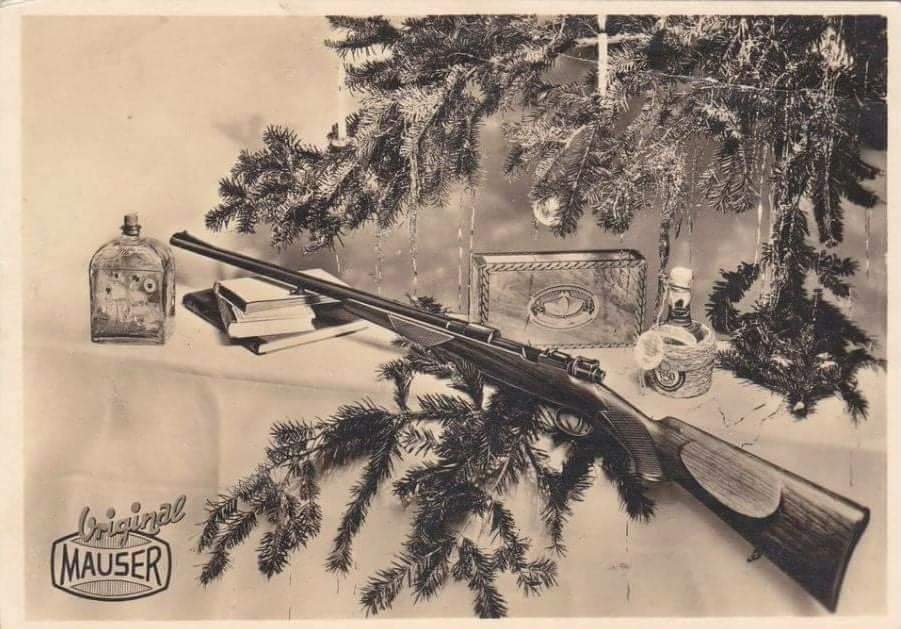
As mentioned in a previous article, secret of 8 mm bullets’ success lies in the sectional density value, a misunderstood and underestimated concept. A .30 caliber bullet and an 8mm bullet have similar ballistic qualities. External ballistics really differs little In a standard caliber, while terminal affects are terribly different: at great distance, a small game hitted by an 8mm bullet would fall, while with an equal weight and construction .30 cal bullet, it would run before falling. I have been able to observe this difference several times, especially on light games. Do not fall into frontal section trap, since energy transfer only partially depends on it. Different behavior depends on low sectional density values, which result in brutal energy transfer. Over time, this gap has been filled by .30 cal bullets technological evolution. Modern ogives, such as the SST and ELDX, are able to guarantee high performance, unthinkable only a few years ago. Same ogives, nowadays, are also available in 8mm, real steroid’s injection for the old Otto. In my opinion, SST bullets are currently the standard to beat. Despite having a not optimal weight, they produce amazing external ballistics, with almost incredible flat trajectory for a standard caliber. Terminal effects are always extraordinary, especially at medium and long range. It could lack penetration on very large games, but this is a risk to run.
However, it should always be kept in mind that these bullets are a novelty, at least an exception in 8mm bullets panorama. Like all nineteenth-century calibers with military past, this too was designed for rounded profile, long and heavy bullets. Extremely long freebores and accuracy are not usually friend. Just in case you have a sporterized military weapon, achieving high accuracy will not always be possible.
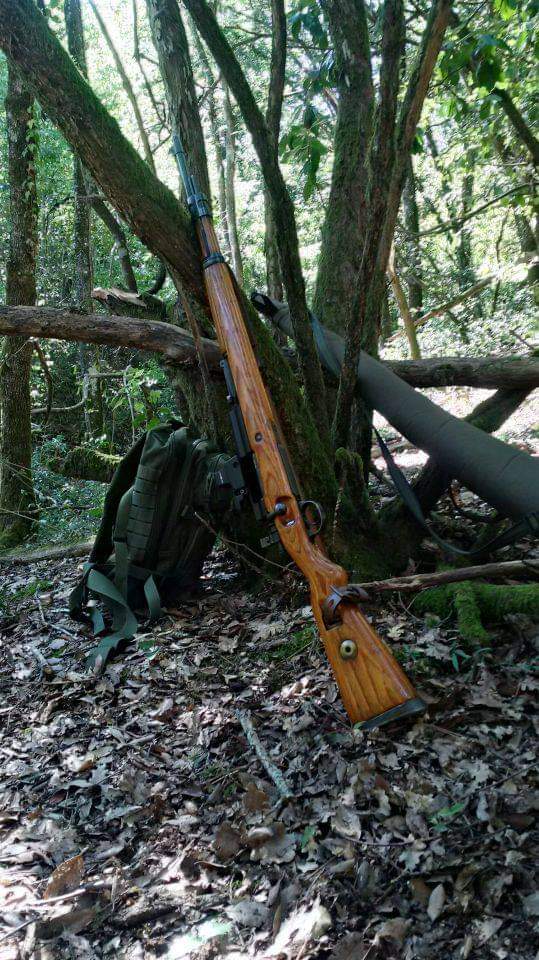
With modern hunting rifles, achieving great accuracy is much easier. It must be said that the main field for this beautiful caliber remains hunting in woods, where shot almost never exceeds 200 meters, and heavy round nose bullets assure straight shots even in thickest vegetation. Best application field remains major European games and a good part of the African ones. Recoil is never punitive, and only in old military weapons with steel butt plate could be hard.

On light framed games we will witness rapid kills usually with limited mest Loss. On larger game, especially It using 200 grain bullets, clean killing is usual, without any run or protracted suffering. Only on very large and viable games, such as wild boars or adult male deer, the old 8 × 57 needs some help. I personally recommend 220 grain ogives Especially for still hunting with a stable rest. Although 200 grains are more than enough for almost any european game, penetration’s advantahe shouldn’t be underestimated in some particular situations: heavy ogives always achieve egress holes, that sound as a good insurance in Quartering in or frontal shots on stout animals. Two holes quadruple bleeding speed, and leave a blood trail that a good hound will not hesitate to follow. I have learned that abundant energy never hurts On large animals, but just in case you get close to a big stuff grabbing the old “Otto” in your hands, better not being unprepared. The first time I was hunting using a K98 in 8x57JS, I shoot a big boar. The animal fell stunned to the ground , then suddenly got up and ran into woods leaving me speechless.
Althoug perfectly hit at the neck, it ran several tens of meters, Without losing a blood drop. Only a blood hound solved the situation, but it was a burning lesson for me. The bullet, a 196 grain soft point, penetrated to the bowels but failed to exit. The copious internal bleeding had killed the boar without producing any trace. An heavier bullet would have produced an exit hole with a different epilogue. Although producing best performance with long and very long barrels, it works well in short barrels too. Like 7 × 57 and 9.3 × 62, it is one of the classic stutzen’s main calibers, the Central Europe’s traditional full stock rifles. Theese integral wooden stock rifles, ideal for precarious supports typical of woods hunting, are surely the most elegant and beautiful to see. They only have drawback of being rare and very expensive. There is another hunting terrain where the old Otto excels suffering competition only with his muscular cousin 9,3×62: the recovery of wounded ungulates. The excellent stopping power, amazing penetration through vegetation and obstacles, together with good performance in short barrels, make it a master choice for trackers.
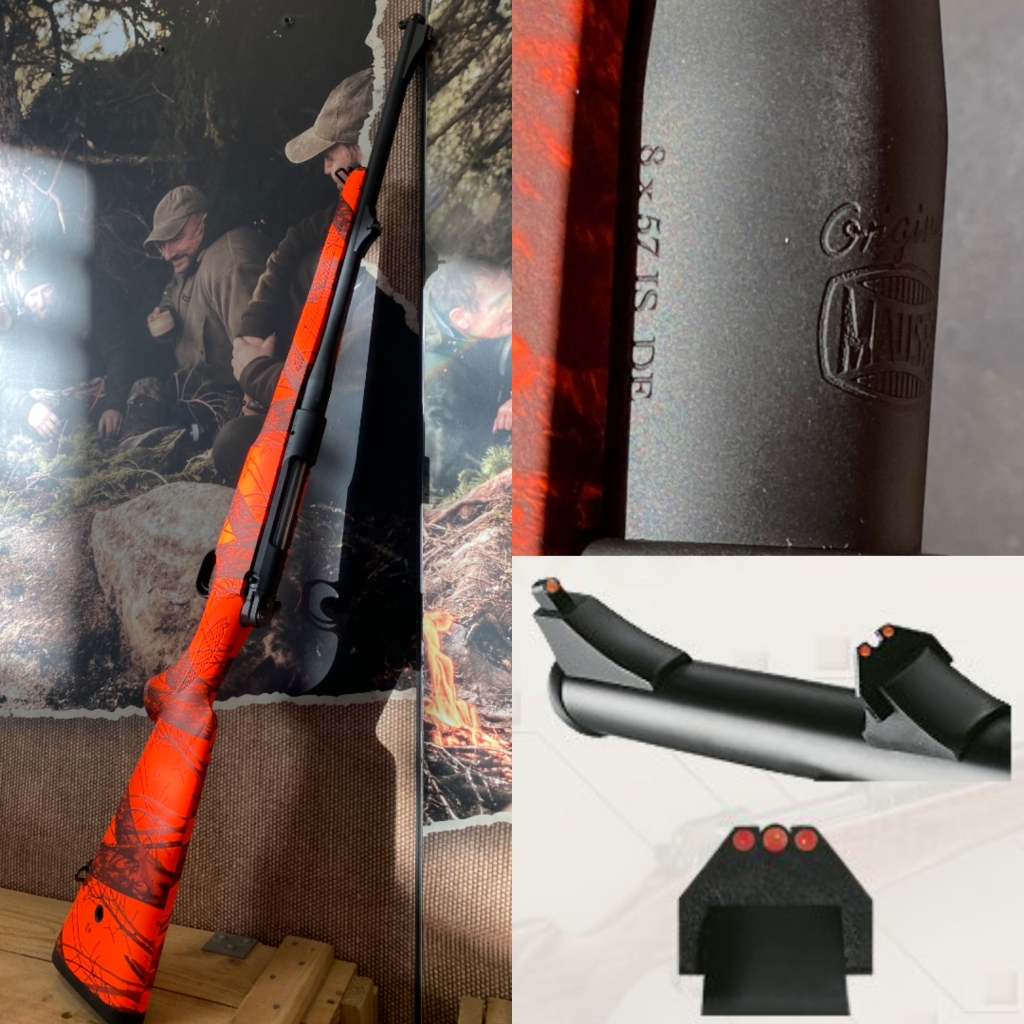
The heavy and soft bullets with which it is usually loaded are an additional insurance for the safety of the track dog. Today there are rifles specifically intended for blood dog handlers, light, reliable and above all very agile in the narrowest passages and in the most impenetrable dense.
Blood trailing is a closed and beautiful universe, made by ahandful, chosen people who work side by side with their auxiliaries, phenomenal dogs that seem to speak with theyr drivers: in a mad world where “object dogs” are an horrible substitute of human relationships, seeing a blood hound at work with its driver is able to open your heart and nourishe the soul.
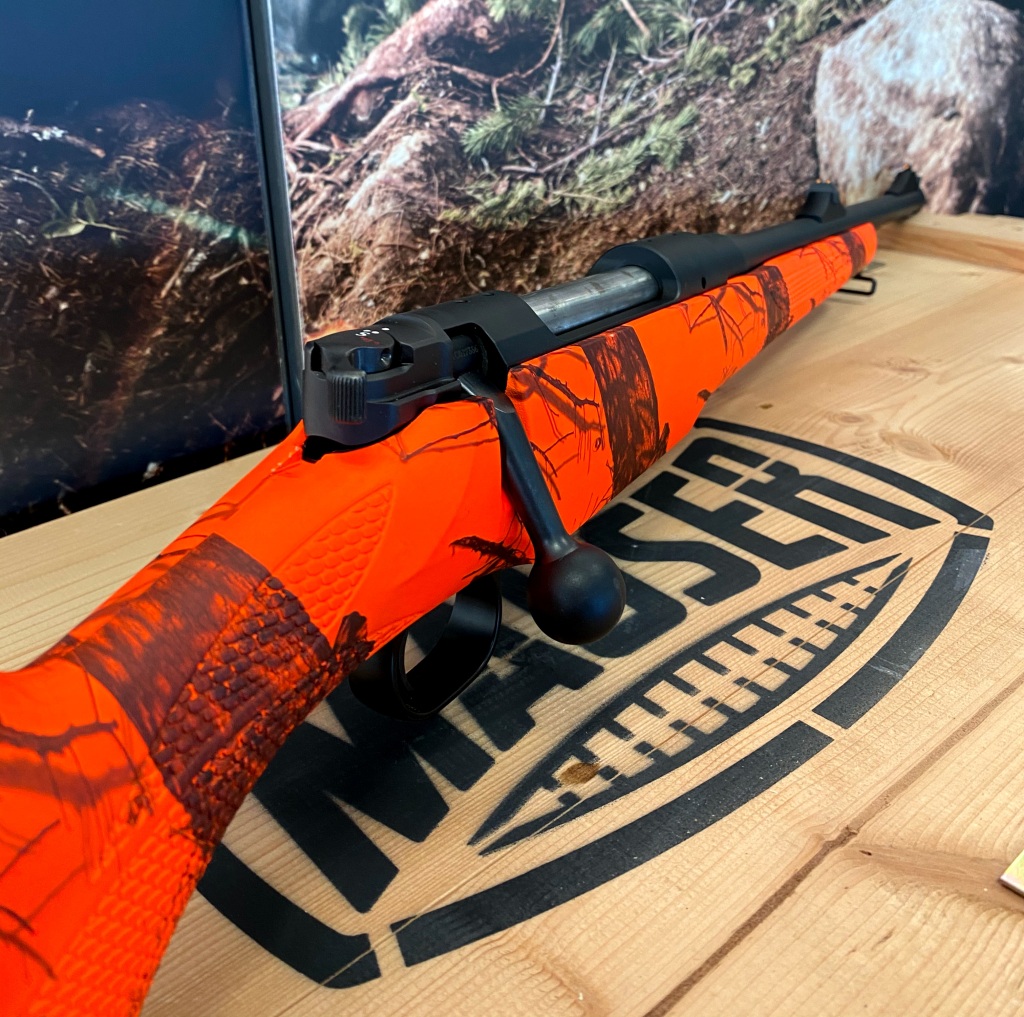
Before going on with technical aspects, lets take a look at the African parenthesis, an important chapter for 8x57JS. When Germany expanded its borders into Africa, many were the settlers who abandoned their native soil looking for opportunities in the black continent. They mostly were in search of fortune, or people who had lost everything and tried a new path. They weren’t wealthy travelers, and at best they had an old 98 from the Great War as only defense against beasts and crop raiders. Of course these weren’t best tools to deal with buffaloes, elephants and lions, but even in the extreme african conditions ,the German caliber was able to achieve high standard. For many years it was the only one available in German colonies, together with the less performing 7 × 57. 200 and 220 grain ogives, both fully jacketed and soft point, soon gained in popularity. Terminal effects were not exhilarating on big game, and it soon became evident that a new cartridge that could enable the colonists to defend themselves and their crops was essential. The good “Otto” was the starting point 9.3 × 62 developing. The brilliant Otto Bock, with remarkable intuition was able to exploit Model 98 in the best way: He designed a new cartridge with the same 8x57JS rim diameter, roomy case topped with a 9.3mm bullet. Simply replacing the barrel, the K98 could had been transformed into an hypertrophic rifle chambered in the outstanding 9.3 × 62, able to kill pachyderms and buffaloes with monotonous constancy. The working pressure was the same, within 3900 bar, so that weapon’s reliability remained unchanged, to guarantee a long life to both weapon and hunter. The proven 98 action continued to work with unshakable reliability, even in hot climates and prohibitive conditions.
We have deliberately left out one of the absolute records of this champion of the past: old Otto was’nt only the first german smokeless powder caliber, not only the first filled with Bibasic powder with Nitroglycerin, a component that makes the powder insensitive to humidity, not only was the first with modern performance, supersonic up to 1000 meters, a steel jacketed Boat Tail bullet with Exorbitant Ballistic coefficient. No! Because the M88 ammunition, created by the Gewehr-Prüfungskommission in 1888, was also the first rimless ammunition in history. Design was so good that it was proofed in the hardest and most difficult of theaters, the War. Never before had a military caliber been designed without a rim. In addition to being a mechanical block, ensuring correct chambering, the rim was a solid and reliable grip for extractor nail, guaranteeing spent cartridge extraction even in the worst conditions. The downside of the coin was a necessary attention during the loading phase, a not excellent feeeding from magazine, and a certain tendency to jam with dirt and shot residues. The monstrous 8x57JS, on the other hand, did not show any problems when filling the magazine, being the ammunition inserted in special plates of 5: the soldier only had to place the plate on the solid recess on the action and push down with his thumb. In an instant the magazine was full and the rifle ready to go. Guaranteeing an absolute loading fluidity was only half the battle, because ejection of spent cartridge was probably even more vital. A rimless cartridge was an unprecedented engineering challenge, and only the sublime 98 action was up to par. The key concept remains the same: not the ammunition, thew weapon, or the army. The joint between Mauser 98 Action and 8x57JS cartridge is the backbone of the military doctrine from 1888 to 1940, there is no separation, one would not exist without the other, a perfect and lasting marriage. The Pronounced shoulder is perfectly to “unglue” cartridge case from the chamber, the neck is able to hold long bullets, but perfectly proportioned at the same time, suitable for automatic weapons with high fire rate.
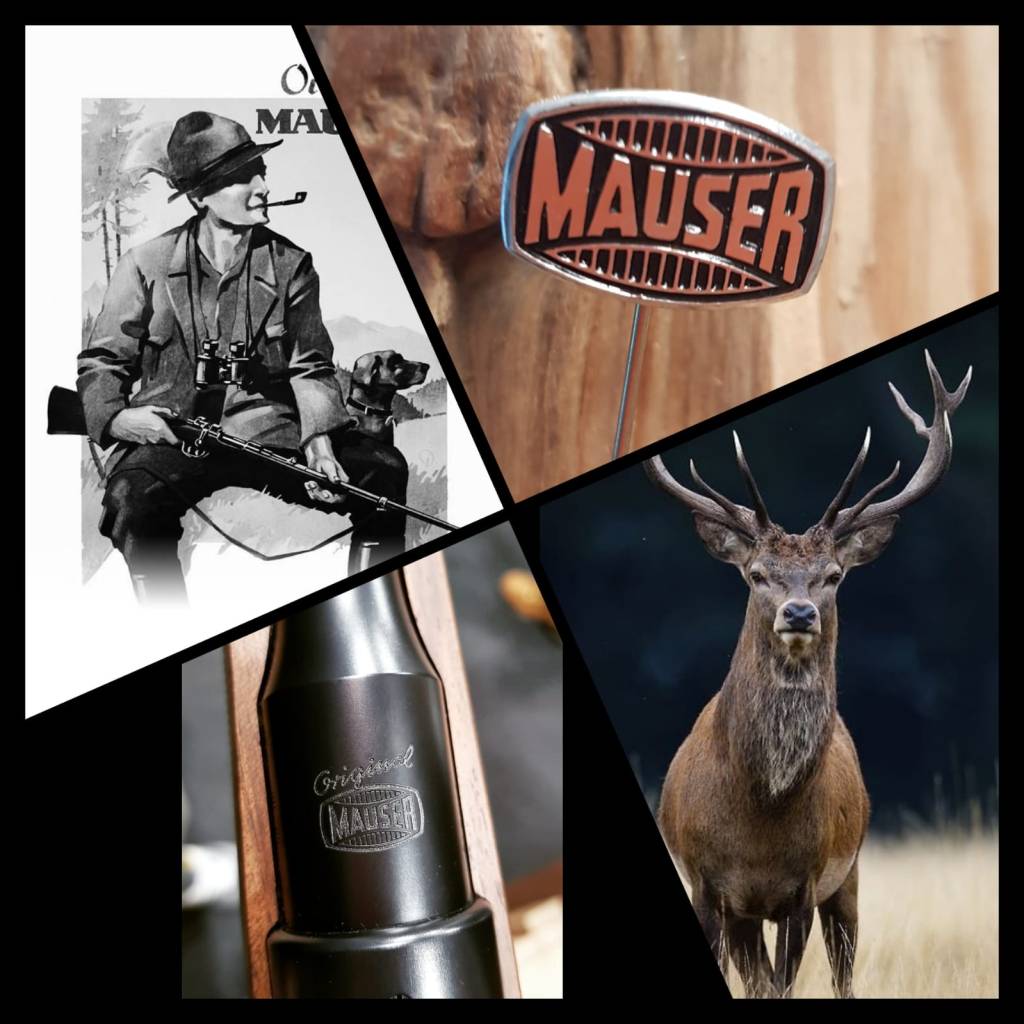
Internal brass’ volume is not so great, but enough to obtain remarkable performances with today’s powders. Operating pressures are never exaggerated, good quality cases can last years.
For hunting standard primers are always recommended, while for extremely cold climates the handloader could consider magnum primers, as recommended by Norma’s manual. When handloading for hunting, pay great attention to case preparation: this aspect is often overlooked by several sources but assumes fundamental importance where when looking for accuracy. While this aspect is not so important with military rifles, if we consider hunting weapons things are different: chamber will be extremely thight and will require adequate care in case’s preparation. Always pay attenction to cartridge lenght, because if the old military rifles had a long free bore, modern hunting weapon could be really different.
The same caution must be used for powder doses, since you can find hundreds of them online, but often refered to 13 grams spitzer bullets. Hunting ogives could generate considerably different pressures due to weight and construction, so you should always refer to a good reloading manual and be prudent. Another good advice is to buy high quality Dies; there are many cheap ones, better suitable for military weapons and not adequate to high quality rifles. Always remember that case is handloading’s core, having perfect shells is more than half the battle. Good quality dies will cost more but you will have all cartridges of same length, without checking them one by one. For the rest, preparation is usual: once formatted and trimmed to length, cases can be primed and reloaded.
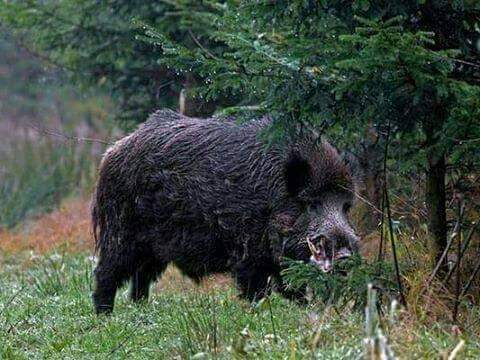
There are a lot of usable powders. They range from the eternal N140, N160, up to the superb Norma 202, 230B, 204 and even MRP, passing through the recent RS50 and RS60. Slower powders will give excellent performance with longer and heavier bullets, recommended for monolithic and bonded pills. For those handloading for stutzen or short barreled rifles, faster powders are better way to achieve complete combustion and respectable energies. Generating longer flame than the standards, Magnum primers could improve combustion in short barrels, slightly raising pressure: a careful overpressure’s signs evaluation is crucial to obtain safe and extremely effective cartridges in short barrels. When reloading 8x57JS and 8x57JRS I have always used standard RWS primers, obtaining excellent consistency and precision. It should be noted, however, that I have always used 60 cm barrels and usually heavy bullets. When I started with driven hunts, I used a Norwegian K98 with great satisfaction for two seasons. I have never liked semi-automatic weapons, while with the old K98 I established an excellent feeling after years spent at the shooting range. Strangely, it perfectly suited me, and I could shoot well while standing, takjng a knee as well as lying down. I just topped it with a red dot, finding a system that didn’t ruin an historic rifle. I developed several hunting loads, helped by friends and skilled old hunters. Results were sometimes disappointing, others thrilling. That heavy old war iron was my pass for handloading, and I think that experience was extremely formative.
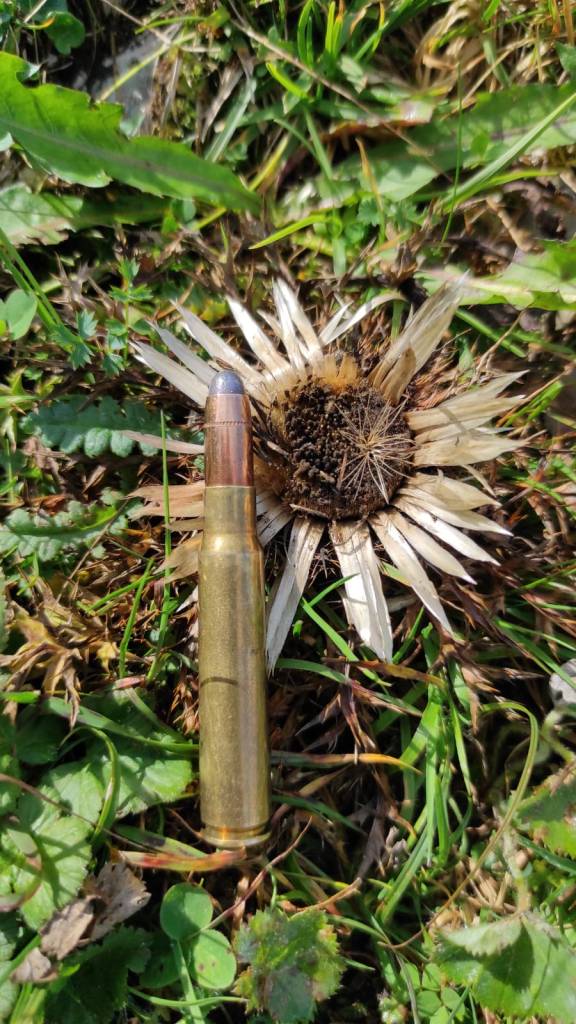
Having just one shot when you have a few seconds to shoot down an extremely vital and potentially dangerous game, forces you to see and think differently. An old friend, an experienced now octogenarian hunter, took me under his wing and taught me to read the forest. Which paths were good, those only used by roe deer, and those that were abandoned. He kept telling me that I was crazy, because one shot was damn insufficient. Every time I killed a boar, he kept telling me that i was crazy anyway. I had two extremely intense seasons. I had many opportunities and the old 98 get the job dome, again. I learned that only field experimentation could give certain answers. In two occasions only i was disappointed. A big boar, after dancing around the drive with all dogs on his back, decided to break through right where I was waiting. I heard it coming and raised old Otto’s long barrel, waiting for it.. So it was. As soon as he saw me, the boar tried to spin and run back, impacting on a mob of howling dogs. After a short fight the boar was back to my post, passing a few meters down. I waited for it on a “good path” and suddenly it passed at full speed, taking a bullet behind the shoulder. With enormous disappointment the boar went straight, as if nothing had happened, disappearing into the thicket behind me. Dogs gathered courage and chased after him. They found it dying a little further on, but the bad wild boar was still able to wound two dogs. On another occasion, a 120 kilograms boar passed in front of me , trying to slip away, right where I was waiting for it. He stepped out of the thicket and headed for the center of the line hoping to get away with it.
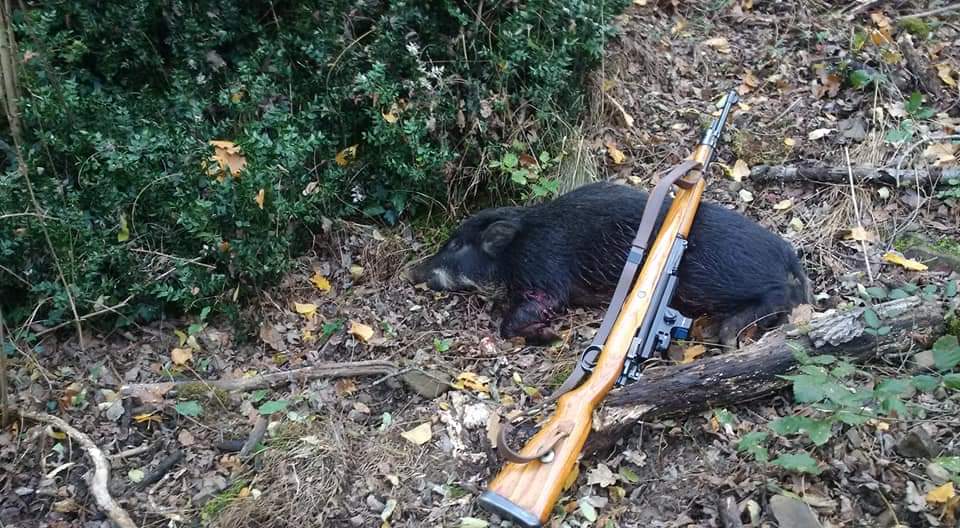
A moment before it disappeared, I shoted its big ass, aiming at the right ham, the only portion still visible. Total disappointment … he went quietly, as if nothing had happened. It was shot down shortly after. Once gutted we found my ball, it had entered the ham without meeting any bones, and had finished its run in bowels. The huge bleeding didn’t stop that beast, that reached its death place walking slowly and breathing hard. Never, on any other occasion, have I felt undergunned, and the story that one shot is insufficient remains just a tale. Counting on a second shot, like with Express rifles, is certainly a nice advantage, but it doesn’t have to be a foothold. In my personal experience 95% games die with the first shot. Only in rare cases have I have been successfull with second. The main culprit in my case is the hunting ground nature, which rarely gives more than a couple of seconds to act in my area. Those hunting in open spaces will certainly have different experiences and opinions. Without a doubt, a modern rifle with excellent ergonomics and a shorter barrel helps a lot. Nevertheless, I believe that the long period spent dragging the old K98 was extremely formative to me. If a boy had worn it in a war, it was not impossible to use it for a trivial hunting trip.
Finally, we come to bullets. Over the years I have used several bullets , many on the old K98, both in drive hunt and still hunting for Fallow Deer and Roe deer, others instead were tested in the monumental 8x57JRS. When choosing bullet, we always have to consider the game we are going to hunt and the terrain we’ll meet while hunting, in order to maximize this fine caliber’s performance. When developing hunting recipes I have always avoided light bullets, in order to obtain best penetration and energy transfer.
SPEER HOTCOR 170 GRAINS.
Curious ogives, exquisitely built for 8 × 57. Like all Hotcor, are bonded bullets, even if the mantle and core are not welded as tightly as other ogives.
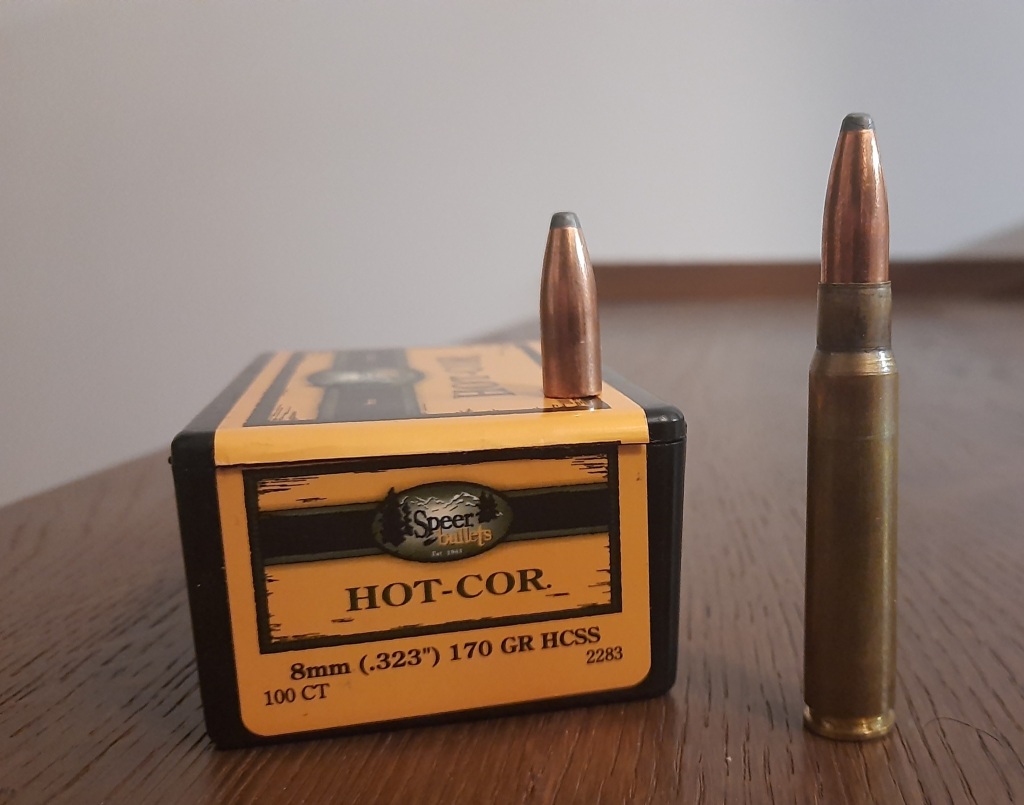
This bullet is prone to shed part of its weight when used on heavy game, altought ensuring enough penetration to reach vitals. Sharp design makes them suitable for rather long shots, with excellent feeding fluidity. Using RS60 I found a fun and accurate recipe, excellent on light framed game like roe deer. Touching 870 ms it’s one of the funniest cartridge for the good K98, with excellent flatness and pasty recoil. They are recommended for both light game hunting and recreational shooting seen the cost. I would put 100 kg of weight as precautionary limit, especially on adrenalinized game. If hunting from a blind with a valid rest, you could risk something more.
HORNADY SST 170 GRAINS.
REVOLUTIONARY.
I don’t know how else i could define these splendid bullets. Hornady designed them for 8x57JS, creating a bullet never seen before. The idea behind the project was an high ballistic coefficient for a never seen before external ballistics, flat trajectory and energy conservation. The result is simply stunning.

Thanks to boat tail profile and aerodynamic polymer tip, SST bullets aren’t only accurate, but also damn effective. Achieving high speed, close to 870 ms, is a joke in 60 cm barrel, so that shots up to 250 meters are compensation free. High ballistic coefficient means shorter bearing surface, nevertheless long barrel and slow burning powders enhance precision and achieve good performance. Terminal ballistics is superlative: we will have lightning-fast knockdowns on light game, with immediate energy dump. 170 grains weight does not suggest extremely long shots and surely requires attention with strong wind. Like all Hornady bullets, SST is equipped with Interlock Ring, preventing mantle and core separation. This should ensure effective penetration even on large gamers; Anyway I wouldn’t recommend it for heavy games seen the relatively light weight. At medium-short distance, i’d suggest to deliberately aim at the neck if engaging very large Game. Blatt shot is certainly able to reach vitals achieving quick kill even on heavy game. SST design does not suggests it as an good bullet for 8x57JRS. Barrels collimation is usually done using round nose bullets, so trying to square the circle with such different ogives could be difficult. Still hunting is probably best suited for these fine bullets, with roe, boar and fallow deer as best employment. I wouldn’t use them for deer hunting during the rut, when an heavier stout bullet is preferable. RS60, as well as Norma’s 203B has proven to be excellent. For those wishing to load them on an old K98, a scope is essential: the ballistics is too different from the 200 grains spitzer the rifle was zeroed with in the far ’30s. It’s possible to achieve perfect hunting ballistic with a decent scope, employable up to human huntnig distance. Accuracy is much better with modern rifles, perfectly suitable for hunting in woods and stalking. I have never tried them in 8x68S, where they should be great for long distances, but probably i will in future.
• HORNADY ROUND NOSE 170 GRAINS.
Versatile and effective. Ultra classic bullets, with timeless design. I used them in 8x57JRS, reaching good collimation at 50 meters in few tests. It’s effective at moderate speed, dumping energy and reaching vitals on medium game; rounded design allows close shots also in thick vegetation.
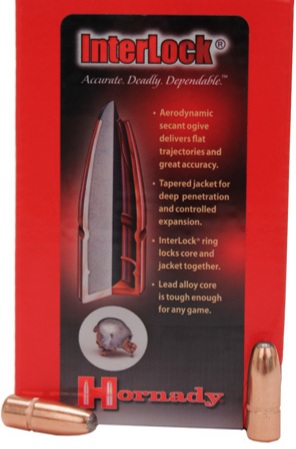
Scarce availability and the rather light weight are the only limits. I observed a lack in penetration on heavy games. It was one of the best ogives for practice and medium game hunting, seen the cost.
• RWS H-MANTEL 187 GRAINS.
Eternal and effective. Together with the TIGs, they are certainly the “Highlanders”, the most famous ogives on the market. Dual core structure, that influenced dozens of producers, is a world famous sight mark. The front core is hollowed, surmounted by a small dome that start the violent expansion and fragmentation.
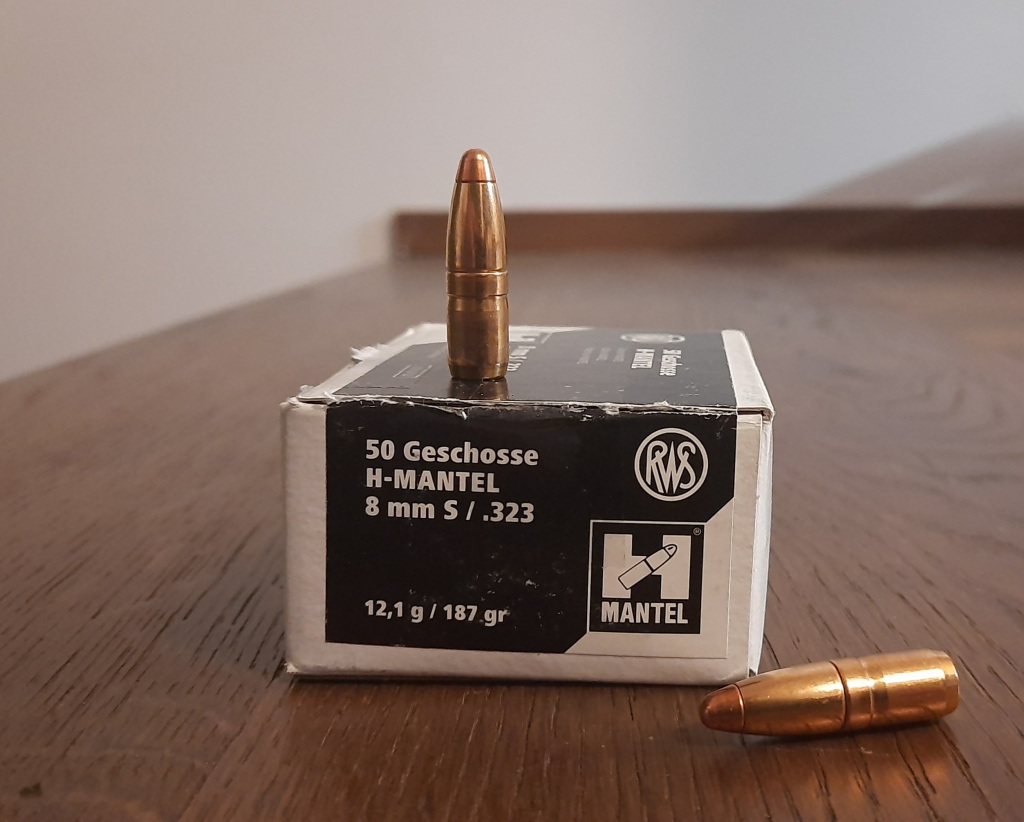
The rear one is hard and deeply penetrating in order to achieve clean and punched egress hole. It comes to us from a time when bonded bullets didn’t exist, when dual cores were ideal solution, producing immense wounds and ensuring clear blood trail for the faithful blood hound’s joy. While these ogives express their enormous potential in 8x68S, in the more placid 8x57JS they are far too tenacious. Anterior core works adequately only on heavy games, without any emphasis anyway. Personally I believe they are too stout , even at a short distance, for this mild caliber. They don’t cause any feeding problems, while the rear core’s structure tends to generate high pressures requiring attention when develping load.
NORMA VULKAN 196 GRAINS .
An evergreen. One of the best 8mm bullet ever tried. Many legends was born to these splendid ogives’ detriment, all imputable to incorrect use in drive hunts.
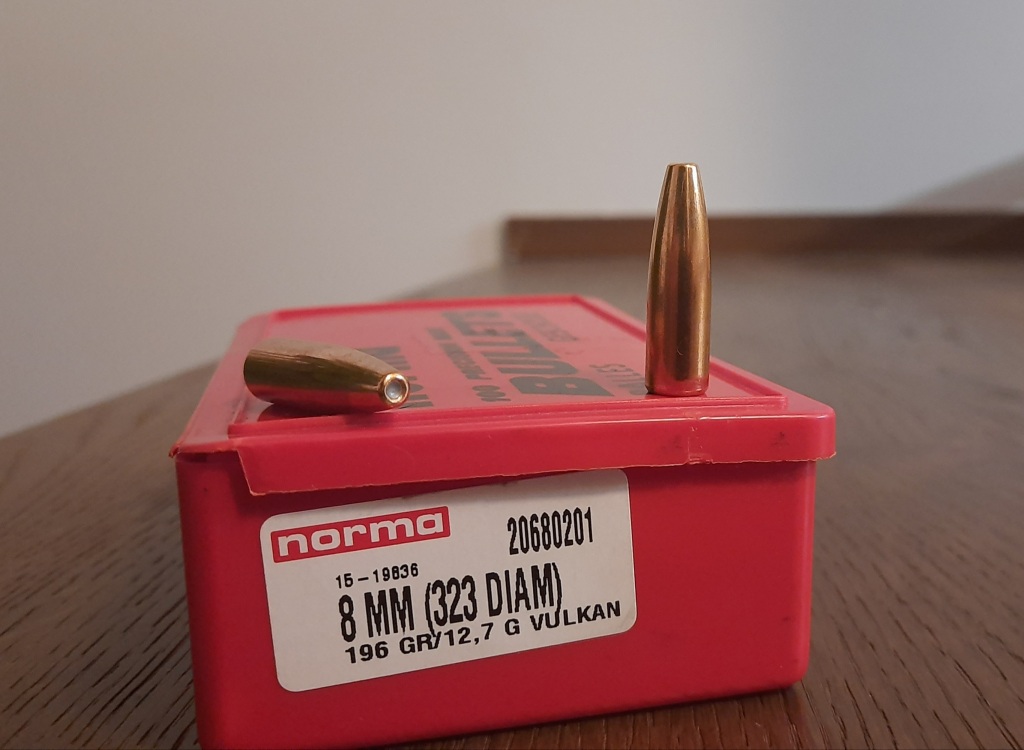
They were not designed for close shots, especially on large and massive games such as wild boars. Nevertheless, when Used in 8x57JS, as well as in 8x57JRS , they can handle violent impacts, being stouter than .30 and 9.3mm homologs. Norma loaded them in 8x68S until a few years ago, so it was probably designed for high speeds; At typical 8 × 57 speeds, they guarantee deep penetration and high energy dump. Expansion will never be violent at long range and killing will not be rapid on light framed game. We will always witness clean, quick kills on heavy game, even above 150 meters. It will be possible to hunt large games , relying on penetration, excellent energy transfer and high precision even at a distance, being Vulkan an heavy bullet with good ballistic coefficient. Bullet design guarantees excellent feeding even in semi-automatic weapons while it’s quite easy to obtain accurate and reliable loads for the 8x57JRS. My advice, when handloading double rifles, is always to get as close as possible to original cartridges performance’s, strarting from there to schieve best grouping.
NORMA ALASKA 196 GRAINS.
Superb.
Excellent in 8x57JRS, so much that almost all manufacturers zero their firearms with this bullet. Best kills I have seen in driven hunt were produced by an excellent Merkel double, chambered in 8x57JRS, using the heavy Alaska. Few weapons can be more effective in short and medium shots than a good side-by-side Express rifle, whose ergonomics allow instinctive shots in fractions of a second. Gentle old Otto’s recoil allows you to double the shot or to acquire another target with great rapidity.
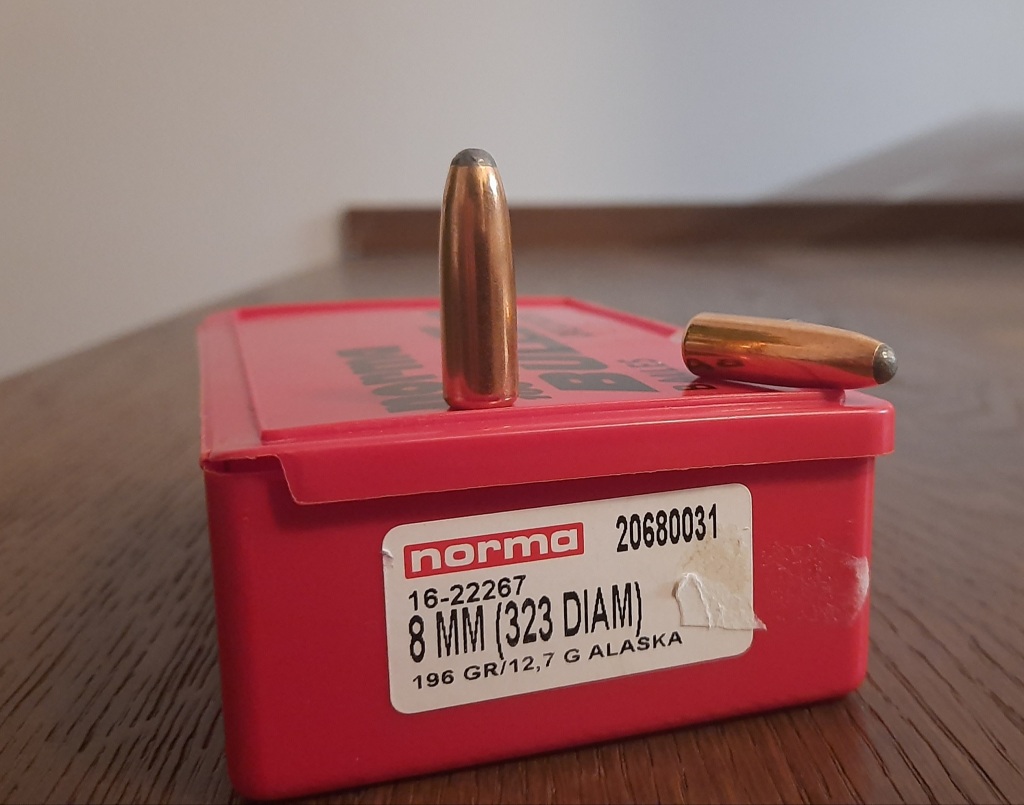
We may witness short run on large games, especially if adrenalinated, but with well-placed shots even huge games will quickly collapse. Bullet goodness is so superb that even pushed at upper limit, results will be excellent. I loaded Alaska in 8x68S, pushing them at high speed, 880 ms, and using them in driven hunts for close shots. They’ve always achieved incredible kills, even on very large wild boars. Even with badly placed shots, outcome was always the same. It’s one of the few soft point remained on the market, and is definitely one of the best bullets ever.
• BRENNEKE TIG 198 GRAINS.
Immortal.
It comes unchanged from the golden age. Project complexity and genial engeneering are evident just at sight. Born by Willhelm Brenneke’s genius, it’s on the field from a century and shows no signs of losing admirers. Like its big brother TUG, this splendid bullet does not stop killing games with absolute meat respect. This old bullet has a decidedly soft front core that assumes an explosive behavior at moderate speeds, followed by an harder rear one that, in addition to inducing fragmentation, produces a net and punched exit hole and a characteristic bell-shaped blood squirt that immediatly identify the anschutz.
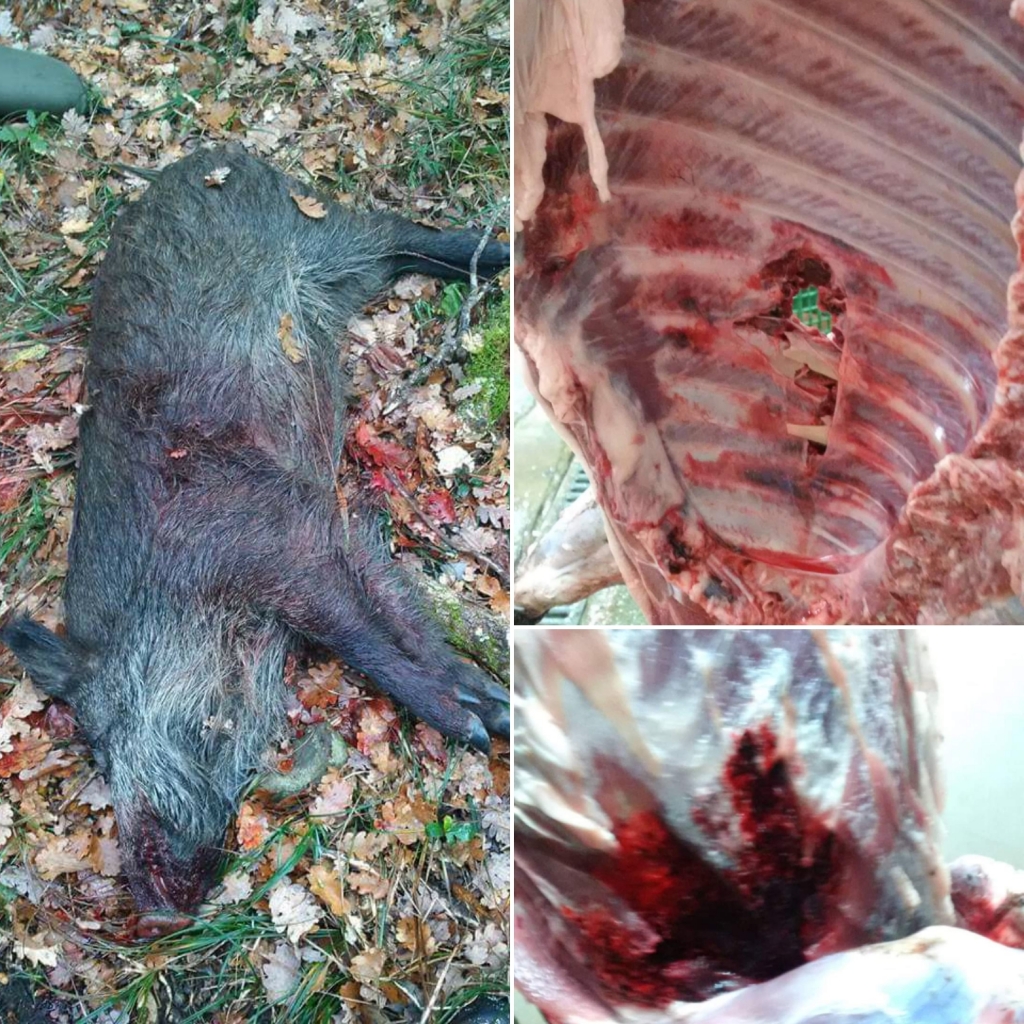
Like other German ogives, the venerable TIG was conceived for a specific use: ungulates hunting in full compliance with Teutonic hunting doctrine. These ogives are designed to hit the Blatt, the boiling room. The anterior nucleus will produce several secondary bullets upon impact with extensive lungs, heart and great vessels damage, resulting in profuse bleeding. The posterior core normally produces a sharp 8 mm egress hole, for an impressive blood trail. This bullet is normally recommended for modest size game, but I can testify excellent results onlarge game. We must understood that relative fragility requires correct shot placement, avoiding shoulder or frontal shots. Blatt shots are always the way to go. I wouldn’t recommend this bullet for driven hunts, while for still hunting I consider it excellent and close to caliber history. Design and bullet weight do not suggest long shots, while within canonical distances it’s more than capable of excellent performance. Remarkable meat respect is probably this ogive’s greatest merit. When correctly used it produces considerable wounds, leaving meat intact. One of the best meat saver.
SPEER HOTCORE 200 GRAINS .
Too hard.
I admit, I’ve tried them for completeness. I used them in 8x68S with some satisfaction, and I also wanted to test them in the old Otto.
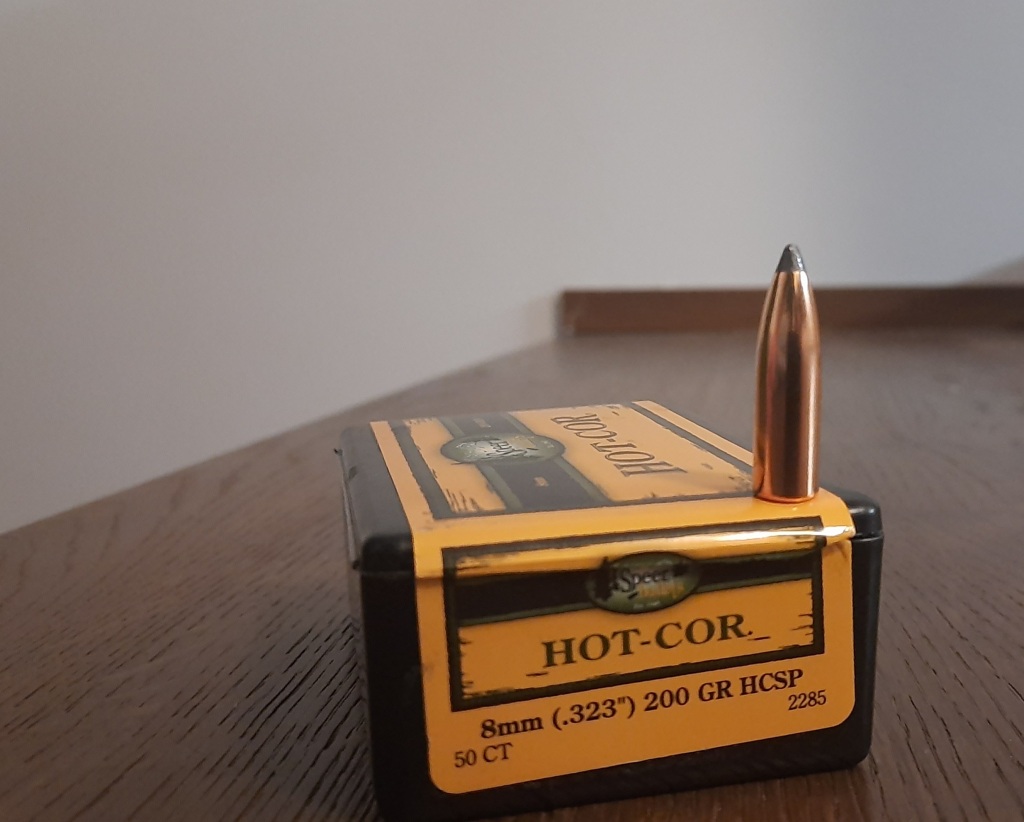
Unfortunately 8x57JS speeds are not able to make this heavy bullet work properly. I have never had quick kills in medium-sized games, while on large ones i had human kills only with shoulder or spine shots. Unless using 8x57JS to hunt large Deer, Bears or Moose at close range, I don’t think it’s suitable. In any case, there are better bullets for the caliber.
Follow us on:
https://www.facebook.com/groups/1100509527013603/?ref=share
• SWIFT A-FRAME 200 GRAINS.
SURPRISING.
We have extensively discussed about these spectacular ogives talking about the 8x68S, and they are certainly exceptional. When I decided to load them in 8x57JS many tried to dissuade me, sure that low 8×57’s speed would never let it work decently. Since that answers are only obtained in the field, I decided to test them. Using N160 I got some excellent groups, with adequate speed. I used them for drivehunts to maximize effectiveness in frontal shots. Results in the field were amazing.
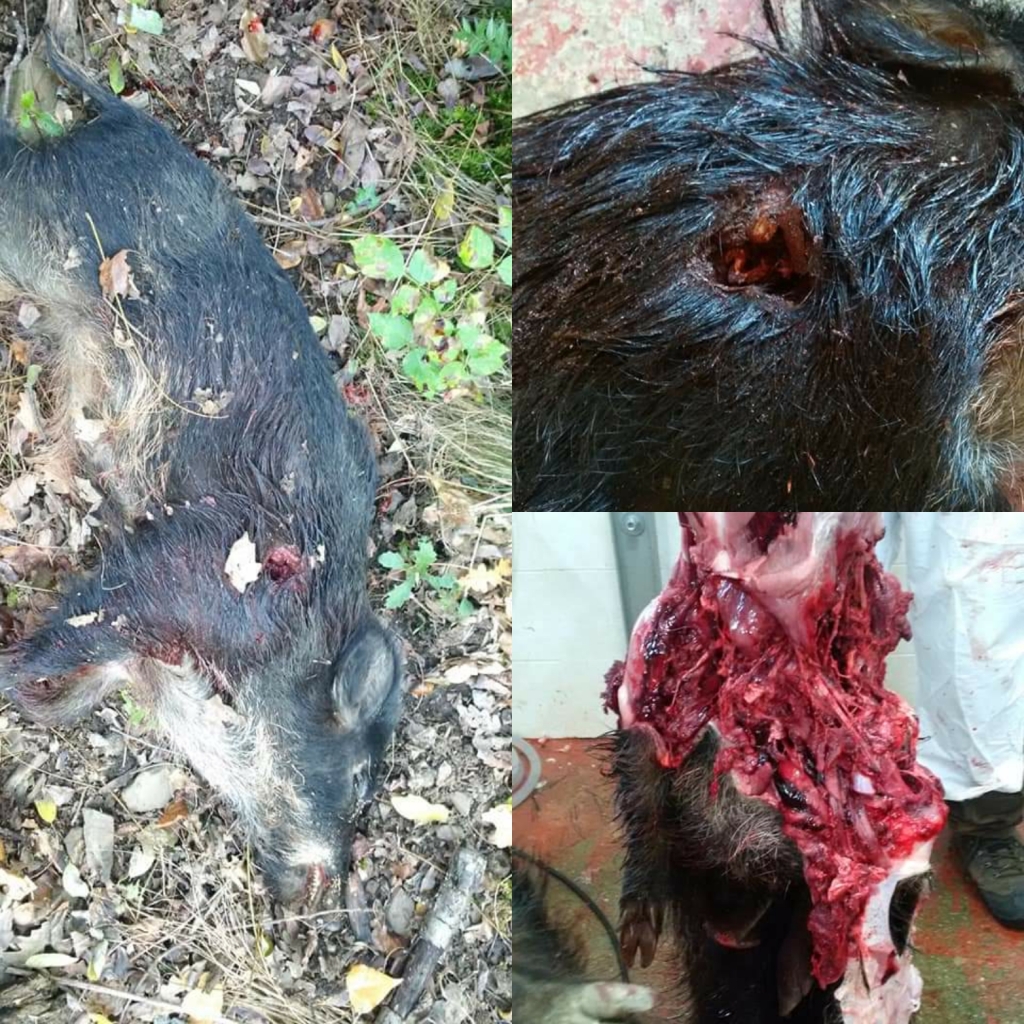
The excellent A Frame produced quick kills, extreme internal damage on both small and very large games. Best kills were achieved with soulder and spine shots, always with notable entry holes and total penetration. As said before these ogives produce very high pressures, requiring attenction when developing the load. Extremely well-finished profile assures perfect feeding and good external ballistics. It is recommended to use these bullets at short and very short distances seen 8x57js tipical speeds, possibly aiming heavy bones or CNC. This fine bullet, as known, has two bonded cores. The front one is soft, the rear harder, both prone to velocity dependable deformation.

Weight retention is always close to 100%, producing exceptional penetration. When hunting large games, such as deer, moose and wild boar, or when looking to maximize deep penetration, they are certainly first choice. The same 220 grain ogives, on the other hand, are definitely too hard for the mild 8x57JS.
• RWS KEGELSPITZ 224 GRAINS.
Now out of production, the ones I absolutely regret.
Heavy, long and damn deadly. Despite the aspect they just were normal soft points bullets. Exquisitely born for 8x68S, they find good application for short and very short shots if loaded in 8 × 57.
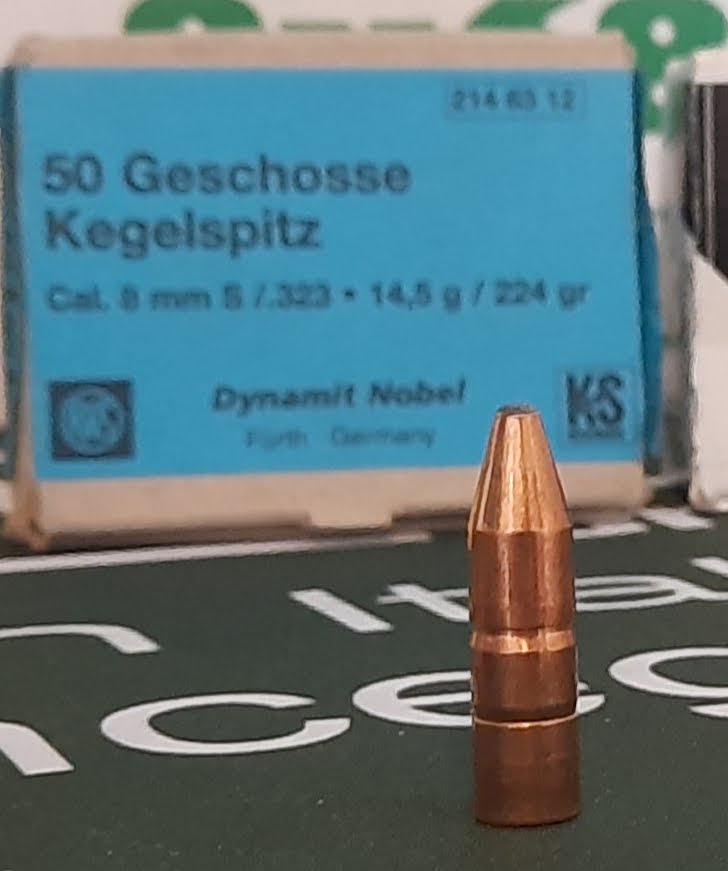
Trajectory is not the best, but if you are looking for high stopping power and savage penetration they are, or rather were, the best choice. Tapered shape does not create feeding problems, while a careful free bore value is crucial. If you want to see it shines, you have to engage it in frontal shots on heavy games at close range. Terminal effects are disruptive, probably one of the most effective bullet, even at modest speeds. I describe it only out of nostalgia, they are gone for ever….
• WOODLEIGH ROUND NOSE 220 GRAINS.
STELLAR.
Woodleigh has been producing the best bonded ogives in the world for decades. Being the inventors of the chemical welding process, they had years of advantage to achieve perfect balance and unrivaled performance over competitors. The dynamic Australian company very wisely provides reloaders with best speed range to work within. From personal experience, all Woodleighs can withstand stress and abuse at higher than suggested speeds especially heavier ones. The 220-grain bullet is perfectly suitable for our “Otto”. First of all because it is built to work at typical 8×57 speeds, and secondly because it is able to exalt penetration and stopping power on large games. If you want to hunt deer, wild boars or large African antelopes at a short distance, few ogives are effective and reliable like this one. We suggest to adopt cartridge length that allows good feeding, taking into account the free bore values seen the vintage design. This aspect is very important in modern hunting guns, less in the old K98, designed with different tollerances. For those who intend to hunt large games with iron sights only, it is probably the best bullet, capable of maximizing 8x57JS’ qualities within 50-70 meters. I recommend slow burning powders, such as N160, RS60 and MRP, while only 60 centimeters barrels will be able to achieve best performances. Unlike other bonded bullets, Woodleighs do not generate high starting pressures, making loads free from dangerous pressure peaks. To enhance terminal effect it is of course essential to deliberately aim shoulder or spine. These ogives are designed to progressively deform, transferring only part of the energy and retaining weight. Penetration will always be total, even in difficult quartering away shots. Only in this way will we see lightning-fast, clean killing. The closer we get, the greater the effectiveness. I had the fortune to use these spectacular bullets on placid corpulent wild boars intent on raiding crops; Up to 100 meters i had the cleanest kills ever seen with this caliber. As usual the hunter must understand the close relationship between bullet’s structure and its range of use. Only in this way expectations and reality will not diverge in a disappointing way. I would use 220 grains for deer, or bear hunting, and generally whenever you can get medium-short distances shots. Definitely Recommended, give it maximum confidence.
• WOODLEIGH ROUND NOSE 250 GRAINS.
Heavyweight. The beautiful 250 grain Woodleighs are the heaviest bullets we can use for 8x57JS.
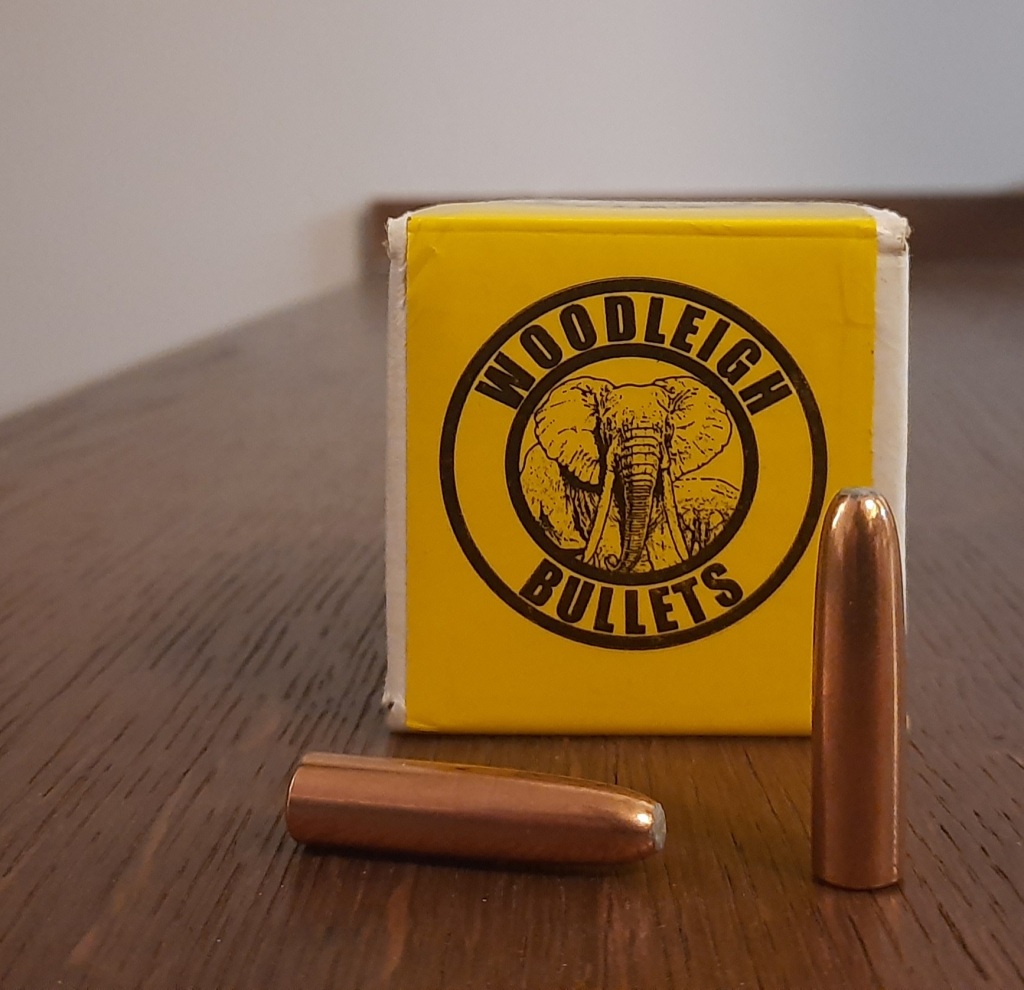
When I discovered that these heavy ogives existed, I immediately ordered a box, sure that they would have some surprises in store for me. Finding a recipe was complex at the time. I mailed the company and they sent me some good suggestions; then I strted with development, obtaining a good group soon. The pot-bellied 250 grains represents a sort of absolute Unicum. First of all it can perfectly mushroom at mild 8×57 velocity, Secondly, can easily achieve unsuspected accuracy and unimaginable penetration. Flexibility is so wide that it can be safely used even in beefy 8x68S, obviously obtaining different effects. According to an Australian friend, these pencil-long bullets were designed for camel hunting. This left me thrilled, and when asking for explanations the story went into legend. In the early 1940s, the Royal Army imported an unknown camels’ number to Australia. The ambitious plan was to deploy them in desert areas and train Australian troops, hoping to replay Lawrence’s succes with camel troop. The Plan was thought for North African front. Needless to say, the project miserably failed , while in the mean time war course drastically changed after El Alamein. Camels were soon forgotten, or rather abandoned. Seen the absence of natural enemies, they proliferated undisturbed becaming a plague. Woodleigh produced these heavy ogives to kill large camelids, seen the numerous 8x57JS sporterized weapons on Australian soil. Whether truth or legend, I have no doubt that such a bullet is able to kill an animal as large as a camel.
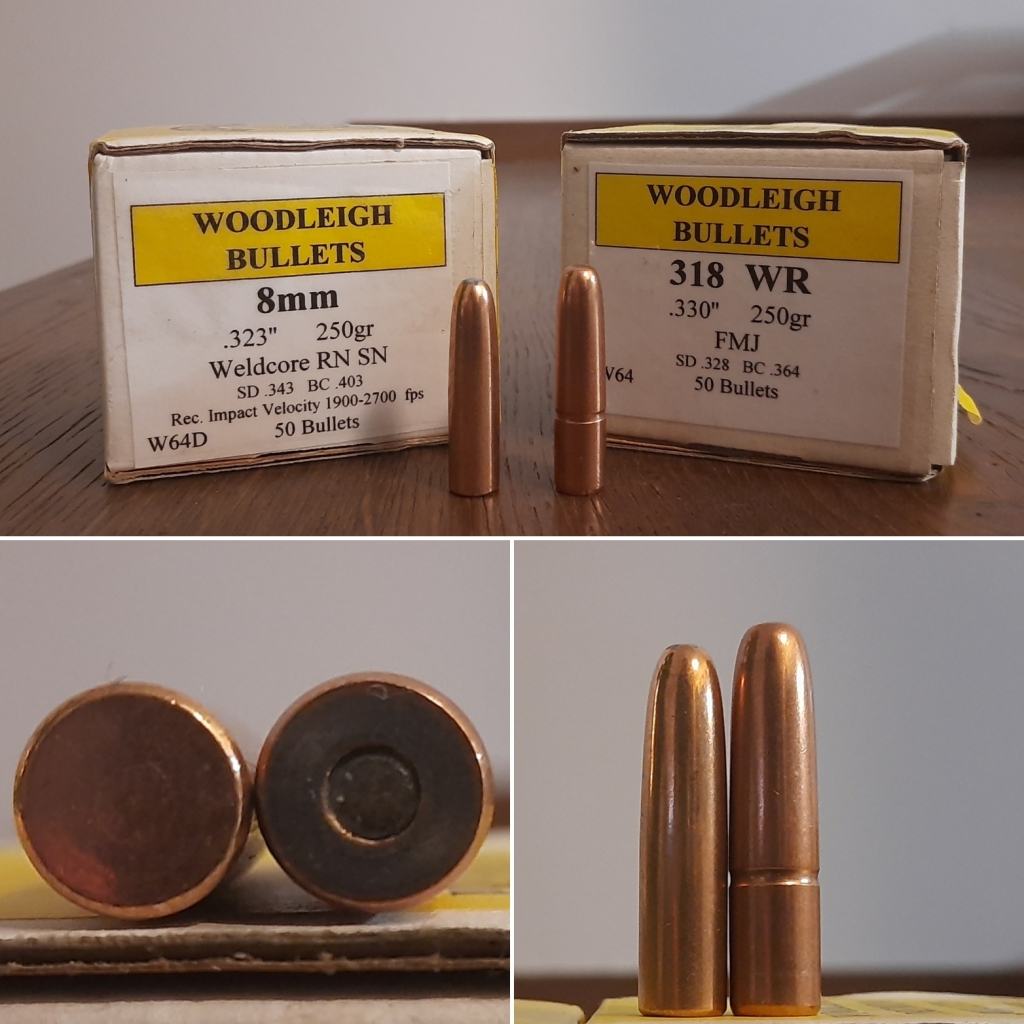
This story kept spinning in my head until I came across a box of rare 250-grain jacketed bullets for the .318 Westley Richards: they are objectively very similar It compared. Ballistic tables never lie. The .323 250-grain bullets have a better ballistic coefficient and a better sectional density than the .318 homologues. .318’s Westley Richards’ muzzle speed and 8x57JS’ speed aren’t all that different if using 60 cm barrel. They are practically equal over 100 meters. If it is true that all african games , including elephants and buffaloes, were killed with the old .318, we can expect comparable performance from the heavy 250 grain woodleighs spited by the old Otto.
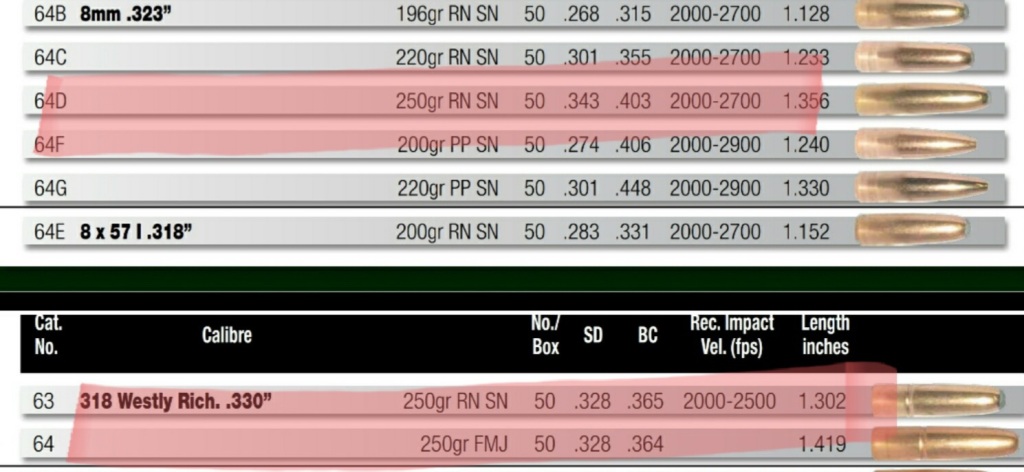
I used them a few times to hunt wild boar. Trajectory is rainbow like, but penetration unstoppable. For those who have to face off-size games just grabbing 8 × 57 JS, these heavy ogives are the only choice. I highly recommend paying attention to cartridge lenght, more then ever. Best powders are slow burning ones, MRP and RS60 first. immediatly Excluding short barrels, 60 and 65 centimeters will be the best performer. Recommendation is always get close, aim straight, hit heavy bones to maximize damage and reach vitals. Considerable barrels’ overheating is probable after few shots due to bullet’s lenght, always keep this in mind when zeroing the weapon. After all there is very little to say … they are simply amazing.
CONCLUSIONS.
After over a century of service, the good 8 × 57 is far from retirement. On the contrary, fast twist rate is ideal for lead free bullets, maintaining accuracy and reliability. If you want a faithful comrade for hunting in woods, you can always count on “Otto”. If penetration and stopping power are required, it has few rivals, while on heavy and vital game, .323 rounded ogives will get the job done superbly . Whether a graceful roe deer or a massive Adult Deer sneaks in, old “Otto” will not betray the hunter. Modern ogives continue to rejuvenate this retired soldier, revealing how bright original project was. While new silly cloned calibers continue to rise and fall in the span of a decade, leaving a faded useless memory, our “Otto” continues to march, unstoppable, stainless, very modern after more than a century.
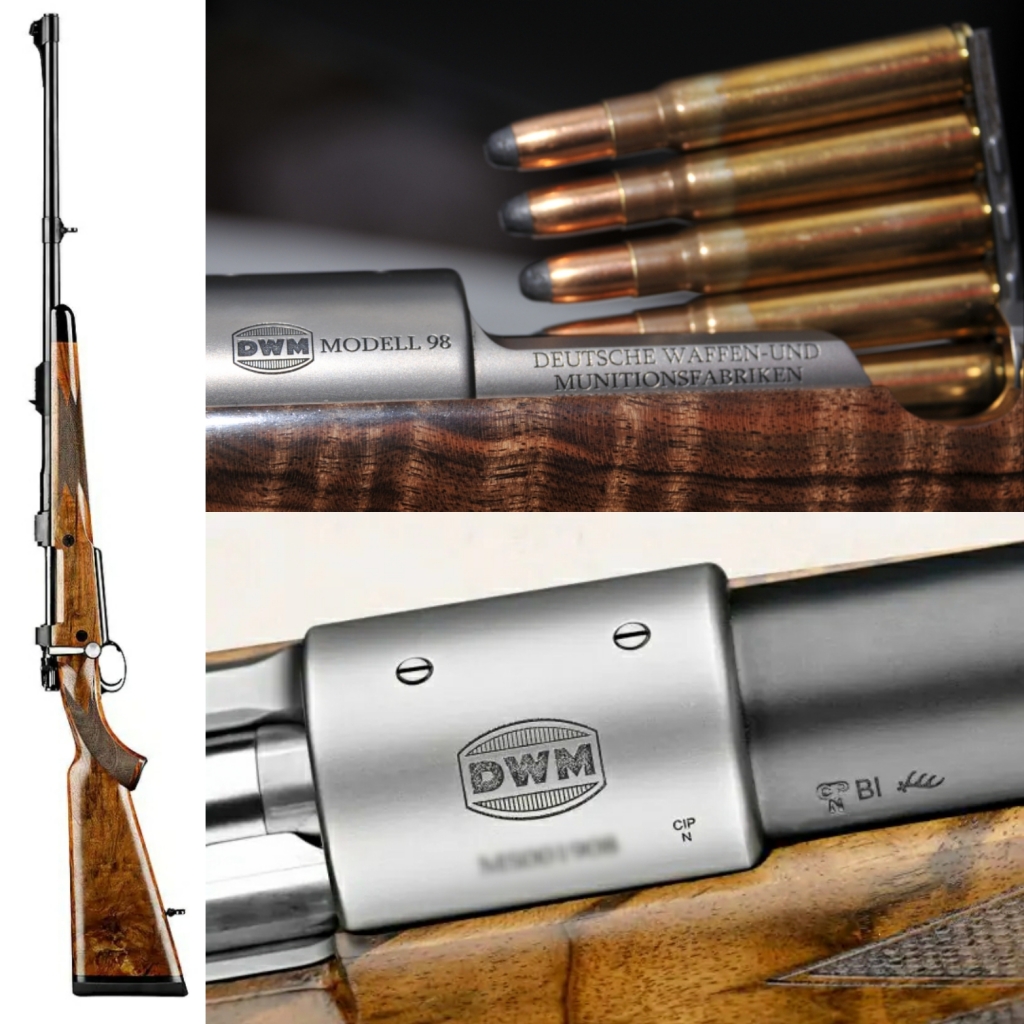
Whether you decide to use a Bolt Action or a very modern Straight pull, you will have a great ally in drive hunts, stalking in woods and hunting from a Blind. If you love fair play and soul loyalty from golden age, with that veiled aftertaste of yellowed paper and pipe smoke, you will appreciate a fine double rifle in 8x57JRS. If you prefer valuable Express when hunting in forest, you will be fascinated and pleased at the same time. While boasting slightly lower pressures and performance, 8x57JRS demonstrate amazing balance. If you know how to adapt yourself to the good side-by-side Express rifle, hunting will assume completely different dimension, more human, less performing and total self control devoted.
Take him hunting, and he won’t let you down. It is not capable of it.
Follow our instagram:
https://instagram.com/mauser_italy?igshid=13jzzw84s5333
Share:
Customize buttonshttps://widgets.wp.com/likes/index.html?ver=20200826#blog_id=181905805&post_id=819&origin=mauserfanatic.wordpress.com&obj_id=181905805-819-5fc94c3d21ed9
Related
7X66 Super Express Vom Hofe The ChimeraIn “Uncategorized”
CHARGE THE BIG 8In “Uncategorized”
9,3×62 indefatigable workhorse.In “Uncategorized”Published bydotchiccoPosted in:UncategorizedEditProtected: 8x57JS, The Warlord.
Browsing articles
Previous articlePrevious article:
9,3X64 Brenneke. Steel fist in a velvet glove
Reply
Authenticated as dotchicco . Go out?
Comment
Notify me of new articles by emailMAUSER FANATIC , WordPress.com .Create your website at WordPress.comCreate your site

Sax 8×57 IS KJG-SR ammunition
https://www.sax-munition.de/sax-_-kjg-munition_2015/39-_-sax-8×57-is-kjg-sr-patronen.html
Bullet: 8 mm KJG-SR (8,2 g / 126,5 Grüna)
https://www.sax-munition.de/sax-_-kjg-geschosse3/14-_-sax-8-mm-s-kjg-sr-_8_22-mm-_-.323_.html
"Mi piace""Mi piace"